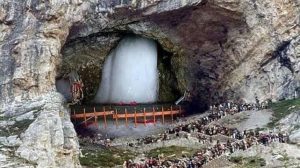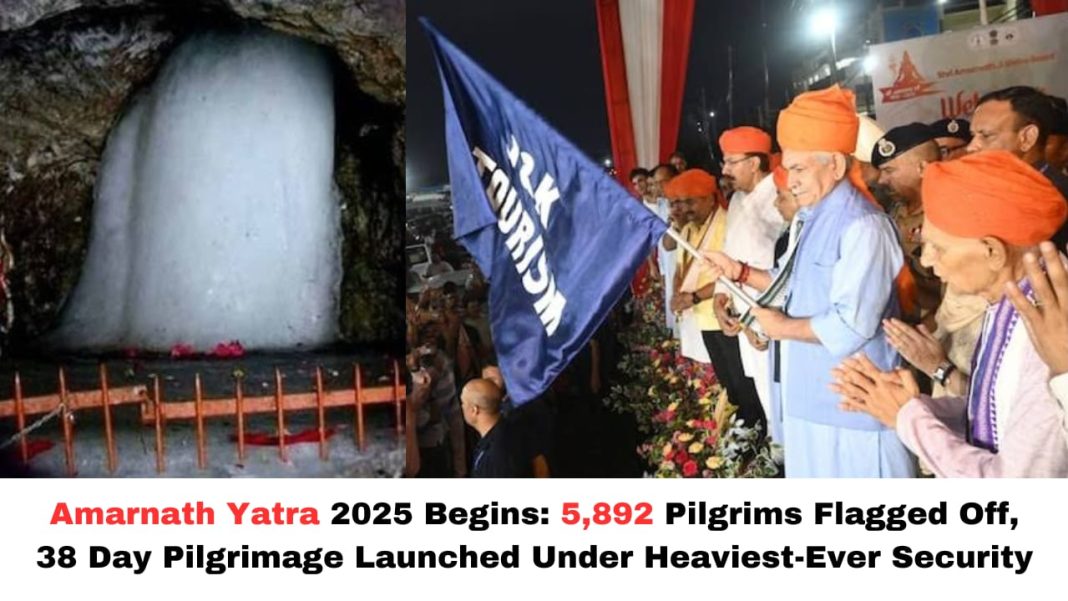Digital News Guru Jammu & Kashmir Desk:
Amarnath Yatra 2025: A Spiritual Journey Begins
The Amarnath Yatra 2025 commenced on July 3, marked by a poignant ceremony at the Bhagwati Nagar base camp in Jammu. Lieutenant Governor Manoj Sinha, who also chairs the Shri Amarnath Shrine Board (SASB), presided over the flag-off, sending off 5,892 pilgrims across 310 vehicles in two convoys—144 for the Pahalgam route and 166 for Baltal—amid chants of “Bam Bam Bhole” and devotional hymns.

This marks the beginning of a 38‑day trek, expected to wrap up on August 9. The pilgrimage attracts thousands annually, making it one of India’s most significant religious events. Revered for the naturally formed ice lingam—a manifestation of Lord Shiva located at 3,880 m in South Kashmir—the Yatra is a journey of profound devotion and endurance.
Route, Registration, & Logistics
Pilgrims traverse two primary paths:
- Pahalgam/Nunwan–Panchtarni–Amarnath: A traditional, scenic, yet longer 48 km trek.
- Baltal–Panchtarni–Amarnath: A steeper, shorter 14 km route favored by experienced trekkers.
So far, over 330,000 pilgrims have registered. Each day, SASB restricts pilgrim numbers to 15,000 to manage crowd density and safety.
Eligibility: Pilgrims aged 13–70 can participate, but those with serious health conditions are advised against straining themselves on the high-altitude trail .
Mandatory documents include a Compulsory Health Certificate (CHC), and pilgrims are required to carry valid IDs and follow traffic advisories on NH‑44 while traveling via secure convoys.
Base camps have been enhanced to support the influx: RFID-enabled tracking cards, biometric check-ins, 100-bed medical units at Chandanwari and Baltal, and improved accommodations.
Security Elevated Amid Threat Warnings
Echoing the gravity of the April 22 Pahalgam terror attack, this year’s Yatra has seen the strongest security measures to date.
- A No‑Fly Zone is in effect over both routes (Baltal and Pahalgam) from July 1 to August 10, barring drones, UAVs, balloons, private helicopters, paragliders, and similar aerial devices. Approved operations, such as medical or official surveillance, operate under a strict SOP.
- Central Armed Police: A staggering deployment of 581 CAPF companies, aided by CRPF, BSF, ITBP, Punjab, and J&K police, supported by jammers, surveillance drones, quick-reaction squads, and K9 units.
- Ground drills: On June 30, a full-scale mock run simulated secure bus convoys under heavy protection to fine-tune response and coordination .

- Convoy movement: Pilgrims are mandated to travel in tightly‑escorted convoys along the national highway, with temporary road closures and time‑based travel regulations to prevent congestion and ensure safe passage.
Overall, about 50,000–60,000 security personnel are actively involved.
Pilgrim Experience & Preparedness
Despite heightened precautions, enthusiasm remains undiminished. Reports confirm that 3.31 lakh pilgrims eagerly await their spiritual journey. Yatris from across India, many sharing messages and support online, are undeterred by recent events.
Infrastructure improvements have been prioritized:
- Widened trekking paths
- Enhanced sanitation and zero‑waste commitments
- Expanded medical and dining support
- RFID trackers and real-time communication ensure pilgrims are not lost or stranded.
Pilgrim convoys departed at dawn—around 4:30 am, sealing the start of their transformative journey.
Why This Yatra Matters
Amarnath Yatra is more than a trek; it’s a symbol of unity, faith, resilience, and national solidarity. Yatris, undeterred by adversity, see it as a personal trial of devotion and spiritual strength.
In 2025, the Yatra carries deeper significance. It acts as a defiant response to terror threats, an affirmation that faith transcends fear, and a testament to democratic India’s ability to preserve sacred traditions under strain.
Summary Timeline
| Date | Event |
| June 30 | Mock drill at Yatri Niwas camp |
| July 1 | No‑Fly Zone begins |
| July 3 | Flag‑off of first batch (5,892 yatris) |
| July 3 – Aug 9 | Active trek period mode; strict security and crowd control |
| Aug 10 | No‑Fly Zone lifts |
Final Thoughts
The Amarnath Yatra 2025 unfolds as a story of faith against backdrop of adversity. It blends ancient spirituality with modern logistics—RFID chips, biometric IDs, satellite monitoring, CCTV, and drone surveillance—under a massive security umbrella. It showcases human resilience, and a nation’s commitment to safeguarding its traditions.
For pilgrims and supporters alike, this journey is about seeking blessings, testing endurance, and reaffirming that hope outlasts fear.
You May Also Read: Air India Boeing 777 AI 187 Drops 900 Feet; Triggers Stick Shaker & “Don’t Sink” Alarms Mid Climb









